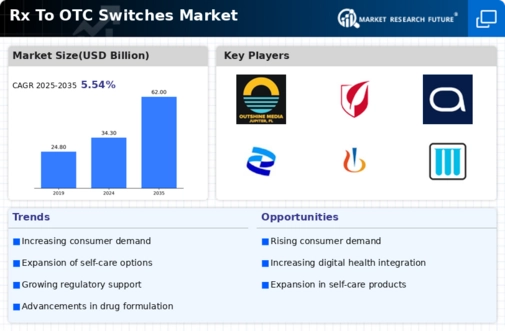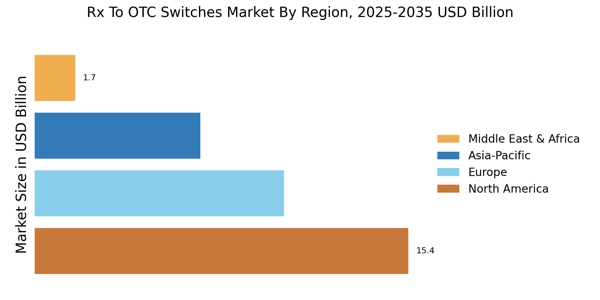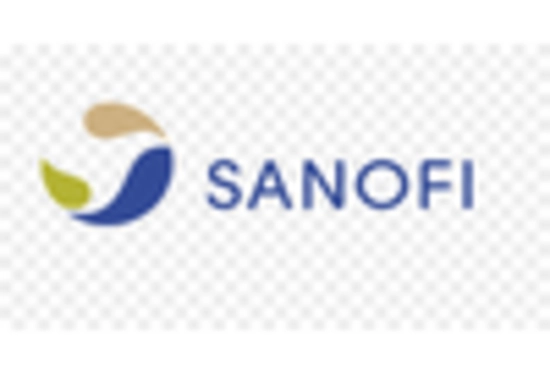Consumer Demand for Accessibility
The Rx To OTC Switches Market is experiencing a notable surge in consumer demand for accessible healthcare solutions. As individuals increasingly seek to manage their health independently, the transition of prescription medications to over-the-counter status becomes more appealing. This shift is driven by a growing awareness of self-care and the desire for convenience. According to recent data, the OTC market is projected to reach a valuation of approximately 50 billion dollars by 2026, indicating a robust growth trajectory. This trend suggests that consumers are more inclined to purchase medications without a prescription, thereby enhancing the Rx To OTC Switches Market's potential. Furthermore, the increasing prevalence of chronic conditions necessitates easy access to effective treatments, further propelling the demand for OTC options.
Cost-Effectiveness of OTC Medications
Cost considerations play a pivotal role in shaping the Rx To OTC Switches Market. The transition from prescription to over-the-counter medications often results in reduced costs for consumers, as they can avoid the expenses associated with doctor visits and prescriptions. This financial incentive is particularly relevant in an era where healthcare costs are escalating. Data indicates that OTC medications can be up to 30% less expensive than their prescription counterparts, making them an attractive option for budget-conscious consumers. As healthcare systems worldwide grapple with rising expenditures, the Rx To OTC Switches Market stands to benefit from this trend. The potential for cost savings not only encourages consumer adoption but also positions OTC products as a viable alternative for managing health conditions.
Regulatory Trends Favoring OTC Switches
Regulatory frameworks are increasingly supportive of the Rx To OTC Switches Market, facilitating the transition of certain medications from prescription to over-the-counter status. Regulatory agencies are recognizing the potential benefits of OTC availability, including improved access to medications and reduced healthcare burdens. Recent initiatives have streamlined the approval process for switches, allowing for a more efficient pathway to market. This regulatory support is crucial, as it encourages pharmaceutical companies to invest in the development of OTC products. The potential for a more favorable regulatory environment may lead to an increase in the number of successful switches, thereby expanding the Rx To OTC Switches Market. As more medications become available OTC, consumers will likely benefit from enhanced access to essential treatments.
Increased Focus on Preventive Healthcare
The Rx To OTC Switches Market is significantly influenced by the growing emphasis on preventive healthcare. As healthcare paradigms shift towards prevention rather than treatment, there is a corresponding increase in the demand for OTC products that facilitate early intervention. This trend is underscored by the rising incidence of lifestyle-related diseases, prompting consumers to seek proactive solutions. The market for preventive healthcare products is expected to expand, with OTC medications playing a crucial role in this evolution. By enabling individuals to address health issues before they escalate, the Rx To OTC Switches Market aligns with broader public health objectives. This focus on prevention not only enhances consumer engagement but also fosters a more sustainable healthcare model.
Technological Innovations in Drug Delivery
Technological advancements are reshaping the Rx To OTC Switches Market by enhancing drug delivery systems and improving product efficacy. Innovations such as transdermal patches, smart inhalers, and mobile health applications are making it easier for consumers to manage their health conditions. These technologies not only improve the user experience but also increase the likelihood of adherence to treatment regimens. As consumers become more tech-savvy, the demand for OTC products that incorporate these innovations is expected to rise. The integration of technology into OTC medications may also facilitate better health outcomes, further driving the growth of the Rx To OTC Switches Market. This trend suggests a future where technology and healthcare converge, offering consumers more effective and user-friendly options.

















Leave a Comment